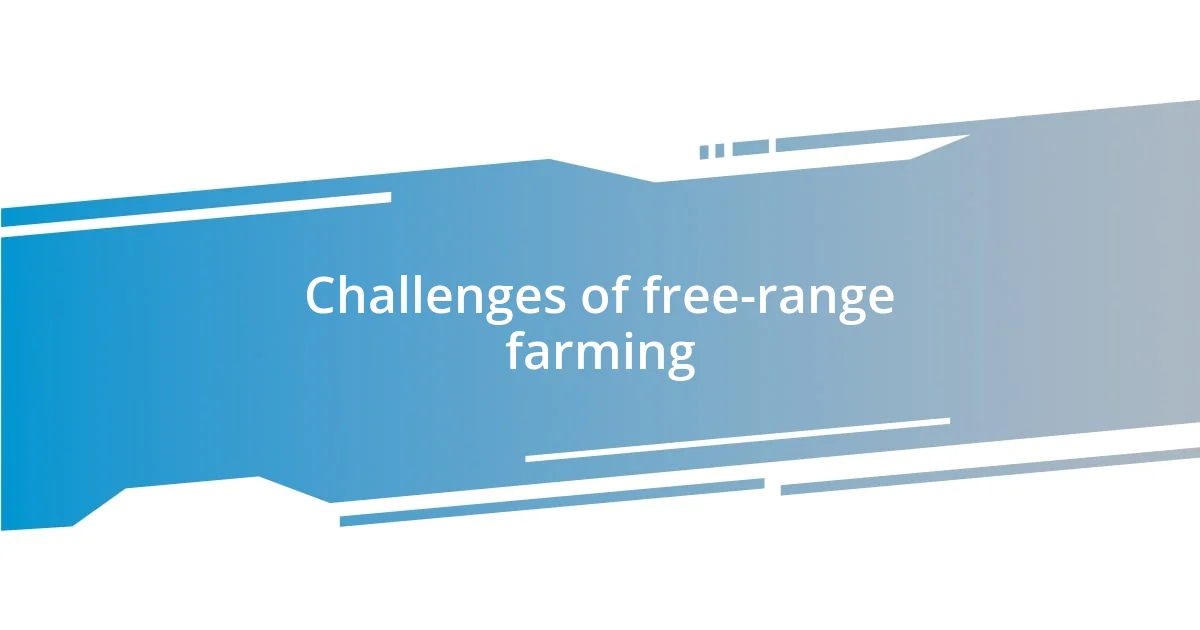Key takeaways:
- The free-range method fosters children’s independence, encouraging confidence, problem-solving skills, and community learning.
- Free-range farming enhances animal welfare by promoting natural behaviors, improving health, and providing superior nutritional quality.
- Successful implementation of free-range practices involves creating secure environments, maintaining pasture health, and establishing routines for animals to thrive.

Understanding the free-range method
The free-range method emphasizes giving children the autonomy to explore their surroundings and learn through experience. I recall one summer when I let my daughter roam our neighborhood freely. Initially, I worried about her safety, but seeing her confidence grow as she navigated the world made me realize just how crucial this independence is for her development.
This approach challenges traditional parenting styles where structure and supervision dominate. Have you ever watched a child get lost in play? The way they engage with their environment, with no boundaries, is absolutely mesmerizing. From my experience, allowing my kids the freedom to make their own choices, even if they stumble, fosters resilience and critical thinking.
At its core, the free-range method revolves around trust—both in children and ourselves as parents. I often ask myself, how much supervision is really necessary? When I let go of my fears and embrace the unexpected, I not only nurture my children’s independence but also initiate a deep sense of community as they interact with others. Ultimately, understanding this method means recognizing the incredible learning potential that lies in embracing freedom.

Benefits of free-range farming
Free-range farming offers numerous benefits that can transform not only animal welfare but also our connection to the food we consume. One of the most striking advantages I’ve observed is the health and happiness of the animals. I remember visiting a local free-range farm, and the sight of chickens pecking around the field, basking in the sunlight, was heartwarming. Their vibrant feathers and joyful clucks were a powerful reminder of what it means for animals to live in more natural conditions.
Here are some benefits of free-range farming:
– Improved Animal Health: Animals that roam freely tend to develop stronger immune systems and exhibit fewer health issues.
– Enhanced Flavor and Nutrition: Free-range products often boast richer flavors and higher nutritional value due to the varied diets the animals enjoy.
– Environmental Sustainability: Free-range farming can promote biodiversity and help maintain healthy ecosystems by allowing animals to contribute to soil fertility through natural foraging.
– Stronger Ethical Practices: Consumers increasingly favor farms that prioritize humane treatment, leading to a more ethically conscious purchasing decision.
By investing in free-range farming, we’re not just supporting better animal welfare; we’re also nurturing our planet and improving the quality of our food. Each bite becomes a testament to a more humane approach to agriculture, enriching our meals and our lives in profound ways.

Key principles of free-range practices
The free-range method is fundamentally about fostering independence. I still remember the first time I let my son explore the park alone. Watching from a distance, I felt a mix of excitement and anxiety. Yet, as he interacted with other kids and navigated the play structures, I saw him make decisions, solve little challenges, and grow more confident with each moment. This autonomy is essential for developing problem-solving skills and self-confidence in children.
Another core principle is respect for the child’s natural instincts. In my experience, children have a natural curiosity that should be encouraged, not stifled. When my daughter found a group of ants on the sidewalk, instead of ushering her away, I stepped back and let her investigate. Those moments of unsupervised exploration provide rich learning experiences that structured environments may miss.
Finally, the free-range philosophy embraces community learning. As I routinely take my kids to various local spots, I see them not just playing but also socializing and learning from others. It reminds me that children often thrive in environments where they can connect and collaborate. This method doesn’t just shape independent individuals; it cultivates a sense of community, intertwining their experiences with those around them.
| Principle | Description |
|---|---|
| Independence | Allows children to explore their environment autonomously, fostering confidence and problem-solving skills. |
| Natural Curiosity | Encourages exploration and learning by respecting children’s instincts and interests. |
| Community Learning | Promotes social interaction and collaboration, enriching the child’s learning experience through connection. |

Challenges of free-range farming
When it comes to free-range farming, one of the most significant challenges I’ve noticed is the vulnerability of animals to predators. I remember my friend who transitioned to this method, only to find his hens constantly on alert for hawks swooping down. It’s a tough reality; while allowing animals to roam free fosters better welfare, it also exposes them to dangers they wouldn’t face in a more controlled environment.
Another obstacle is the unpredictability of weather conditions. Picture this: a sudden storm hits, and your livestock, used to roaming, can become disoriented or even injured. I’ve seen farmers struggle to keep their animals safe during extreme weather. Finding that delicate balance between letting them enjoy the outdoors and ensuring their safety can be an ongoing dilemma.
Finally, managing pasture quality can prove quite challenging. In my experience, keeping the ground healthy and preventing overgrazing requires diligent monitoring. I once visited a farm where the grass had been depleted because the animals had too much space to roam. It made me realize that while free-range farming promotes freedom, it also demands careful planning and stewardship of the land to ensure sustainability.

Comparing free-range with conventional methods
When I think about the differences between free-range and conventional methods, the most striking aspect is the overall environment for the animals. Free-range systems allow animals to roam outdoors, which leads to natural behaviors and social interactions. I remember visiting a farm that practiced free-range. The sheep were grazing peacefully, interacting with one another, and exhibiting behaviors that felt genuine. It reminded me of how important it is for beings—whether animals or children—to express their natural instincts.
On the flip side, conventional methods often confine animals to cramped spaces. I recall a time when I toured a factory farm where chickens lived in such close quarters that they barely had room to spread their wings. It was heartbreaking to witness. While this method may ensure efficiency in production, I questioned the animal welfare aspect—are we sacrificing their happiness for higher yields? That’s a tough pill to swallow for anyone who values the life and well-being of animals.
Another difference revolves around the nutritional quality of products. I’ve often noticed that free-range eggs taste richer and have vibrant yolks compared to their conventional counterparts. After I switched to a local farm that practiced free-range methods, my breakfast experience transformed. It’s fascinating how the animals’ diets and lifestyles impact the end product. Isn’t it worth considering how our choices affect both health and ethics? Ultimately, this comparison sheds light on the broader implications of animal welfare, consumer health, and our responsibility towards food sourcing.

Implementing free-range methods at home
Implementing free-range methods at home can truly transform your connection with your livestock. I remember when I decided to let my chickens roam in our backyard for the first time; the joy was palpable as they explored every nook and cranny. Watching them scratch and peck at the ground reminded me of the freedom they deserve, and it reinforced my belief that animals thrive when allowed to express their natural behaviors. But, the question often arises: how do you ensure their safety while they bask in this newfound freedom?
One practical step I found invaluable was creating a secure space that encourages exploration while keeping potential threats at bay. I installed a sturdy fence that allowed my chickens to forage without fear of predators. It was rewarding to see them settle into their environment, but I also realized I needed to be vigilant about their well-being. Are you considering similar measures? I’d suggest starting small; perhaps designating a specific area in your yard where your animals can roam safely could provide the balance you’re looking for.
Moreover, paying attention to the pasture’s health is essential. I recall an instance where I was overwhelmed by the sheer volume of space and ended up with overgrazing in certain areas. It made me rethink my approach, and now I rotate my livestock through different sections to maintain ground quality. This not only fosters a more sustainable environment but also enhances the overall health of my animals. Implementing free-range methods effectively boils down to mindfulness, planning, and a willingness to adapt—qualities that, in my experience, lead to a flourishing home farm.

Tips for successful free-range care
Creating a balanced environment for your free-range animals is essential for their well-being. I can still remember a day when my ducks discovered a small pond I had created just for them. Their joy was contagious as they splashed around and engaged in their natural behaviors like dabbling and preening. Seeing them thrive in that setting made me realize how important it is to provide spaces that cater to their instincts. Have you contemplated your animals’ specific needs and how you can enrich their living space?
Another tip I found crucial is establishing a routine. Initially, I was a bit haphazard with feeding and checking on my flock. However, I noticed that animals feel more secure with predictability. Now, I feed my chickens at the same time every day, and it’s amazing how they recognize the routine and gather eagerly, like children at the dinner table. This not only helps in managing their health but also strengthens our bond. Have you thought about how structure can benefit your animals?
Lastly, engaging with your animals daily fosters trust and comfort. I recall one evening sitting quietly in the garden as my sheep grazed nearby. They gradually approached, curious and unafraid, and I felt a wave of connection wash over me. It’s those moments that remind me they are not just livestock; they’re companions in this journey. So, how can you make time to connect with your free-range animals? Just a few minutes each day can transform your relationship—believe me, the rewards are worth it.
















